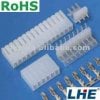
I was about to buy a class I , HLP80H-42
I don't feel so good now. I might just go with Class II
BTW ..
The HLP -80H-42 ,are
Class I ,open frame drivers ...
Pretty " Hardcore " I should say ...
Not for begginers for sure ...
They are great as tasers ,too ..
Tace extra caution ....
(...)
Class I appliances, the protection is provided by a combination of basic insulation
and the use of electrical earth. These appliances must have their chassis connected
to electrical earth by an earth conductor (coloured yellow/green in most countries,
green in the U.S., Canada and Japan). The failure of an electrical appliances basic
insulation may cause a metal chassis to become “live” at full mains voltage. This
failure could occur through faults such as the incorrect fitting of the flexible chord, or a
short-circuit caused by a stray strand of wire bridging the gap to the chassis.
To safeguard against electric shock from metal cased electrical appliances, the metal chassis or
case or any exposed metal of appliances (other than double-insulated items) must incorporate
a Protective Earthing conductor connected to the Earth pin of an approved three pin plug
incorporating an “Earth” terminal. The Earth pin is longer than the other two pins so that it
is first to make contact and the last to break contact when the plug is withdrawn.
By connecting to the metal chassis of the appliance, the Protective Earth wire keeps all
this metal at Earth potential. What this means is that it is impossible to get an electric shock
even when the chassis is connected directly to the live voltage. A fault in the appliance which
causes a live conductor to contact the casing will cause a current to flow in the earth
conductor. This current should trip either an over current device (fuse or circuit breaker) or
a residual current circuit breaker which will cut off the supply of electricity to the appliance.
In practice, the most common instance of faulty earthing are:
•Earth connections broken accidently or
corroded through age.
•Earth connections incorrectly made.
•Earth connections not made at all.
•Earth connection removed for some
specific purpose and not reinstated.
---------------------------------------------------------------------------
In a
Class II appliance, the user is protected by at least two layers of insulation between the
current carrying parts and any metal accessible to the user.
•Basic Insulation, and
•Supplementary Insulation
For this reason, Class II appliances are also known as Double Insulated appliances. They
do not require an Earth connection. In Europe, a double insulated appliance
must be labelled “Class II”, “double insulated” or bear the double insulation symbol (a square inside another square)
f the basic insulation or the supplementary insulation breaks down, it will not result in an
electric shock risk. Protection will be afforded by the other system of insulation. The
accessible metal parts will become “live” only in the event of a breakdown of both insulation
systems. The probability of this occurring is very remote provided special care is taken
when servicing or repairing double insulated electrical appliances to ensure that both
insulation barriers remain effective. Class II electrical products may be any of the
following types:
•
Double-insulated electrical products which
comprise both basic insulation and
supplementary insulation. In other words,
there are two layers of insulation between
the live parts and accessible parts of this
type of product. In the case of products
with outer casing made from insulating
material, the casing will be ranked as one
of the required layers of insulation.
•
Reinforced-insulated electrical products
which comprise single layer of insulation
system to the live parts and provide a
degree of protection against electric shock
equivalent to double insulation.
•
Electrical products which have durable
and substantially continuous enclosure
made of insulating material. All metal
parts, except small parts such as
nameplates, screws and rivets which are
separated from the live parts are enclosed
by insulation at least equivalent to
reinforced insulation. This type of
electrical products is called insulation-
encased Class II products.
•
Electrical products which have
substantially continuous metal enclosure
in which double insulation is used
throughout, except for those reinforced-
insulated parts where the application of
double insulation is obviously
impracticable. Such electrical products are
called metal-encased Class II products.
-----------------------------------------------------
3 : Are Class I and Class II appliances just
as safe?
As both have two levels of protection built in, they are both safe for general use. However
with a Class I appliance, one of the layers of safety is provided by the earth connection. For
this to be effective, the wiring in the building has to be inspected regularly to check that the
Earth in the mains socket is correctly taken to the local earth potential. Class I appliances
depend on the external wiring in the building to fully provide the 2 levels of protection.
Class II appliances however always provide 2 levels of protection irrespective of the status of
the wiring installation. Both layers of protection are built into the design making
Class II appliances a lot safer than Class I appliances
http://www.vitecpower.com/wp-content/uploads/2012/05/Excelsys_ApplicationNoteAN1102-ClassIvsClassII.pdf
Cheers






 ...
...
